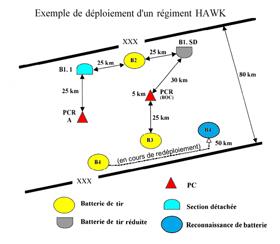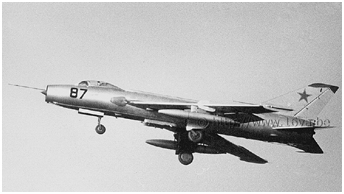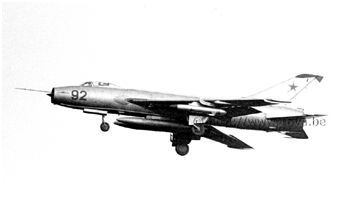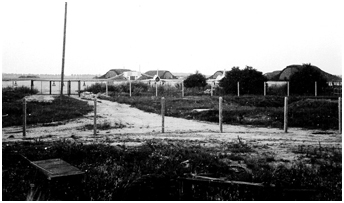Gaston Desornes was a radar technician in the French army for sixteen years. He notably worked on the Nike and Hawk missile fire control radars. In collaboration with former colleagues, he gives us his analysis of the Hawk battery attack plan detailed in the previous chapter.
In the early 1970s, NATO learned of a Soviet plan to open penetration corridors to the west. One of the parts of this plan was the priority destruction of the Hawk air defense units blocking the breaches along the Iron Curtain. The following text [being a summary of the previous chapter with some additional remarks] explains the mechanism the Soviets developed that included combined nuclear and conventional air attacks to achieve their goal. The presentation is followed by remarks from battery commanders and senior Hawk officers serving at the time, and finally from a Hawk instructor and programmer of Hawk AN/TPQ 21 and AN/TPQ 29 simulators.

 The deployment of a Hawk battalion (regiment) occupies approximately a rectangle (a "bean") 80 km deep
by 60 km wide. The arrangement of the four batteries is such that the radar detection and missile firing ranges overlap
and can therefore provide mutual support. Because the Hawk batteries have two independent firing sections, an air attack
of a battery on the ground (by cannon, machine gun, rocket, or anti-radiation missile) supposes that, in order to be effective,
the two fire control radars must be destroyed at the same. Also, this action could not go unnoticed by the three other batteries
and the BOC (Battalion Operations Center) that would react to deal with the intruders.
Moreover, at the time, the Hawk electronic countermeasures against the Soviets were quite well mastered. A high-altitude attack
(bombardment) would not have been entirely effective due to the dispersion of units and equipment.
The deployment of a Hawk battalion (regiment) occupies approximately a rectangle (a "bean") 80 km deep
by 60 km wide. The arrangement of the four batteries is such that the radar detection and missile firing ranges overlap
and can therefore provide mutual support. Because the Hawk batteries have two independent firing sections, an air attack
of a battery on the ground (by cannon, machine gun, rocket, or anti-radiation missile) supposes that, in order to be effective,
the two fire control radars must be destroyed at the same. Also, this action could not go unnoticed by the three other batteries
and the BOC (Battalion Operations Center) that would react to deal with the intruders.
Moreover, at the time, the Hawk electronic countermeasures against the Soviets were quite well mastered. A high-altitude attack
(bombardment) would not have been entirely effective due to the dispersion of units and equipment.
A satisfactory solution was a tactical nuclear assault that could affect the entire battalion at once. The electromagnetic pulse that would instantly disable or severely disrupt but without destroying them, the ADL (Automatic Data Link) communications of neighbouring sectors, would be the "icing on the cake." It should be noted that the Hawk equipment during this period was not yet transistorized and was almost immune to this radiation. However, their communications equipment (digitized TSQ) was sensitive to it. On the Soviet side, specific training was set up with Su-7 fighter-bombers with tactical nuclear capability. The operation consisted of four phases that could be reduced to three depending upon the initial results. It was based on the fact that, in the best of cases, the Hawk battery could only engage two targets at a time at the "T" moment. The very short flight time of the missiles (64 sec. maximum at Mach 2.5) left open a very small window in which to disrupt the attack.
Preliminary phase: Harassment
This phase is optional, but it is recommended in an initial assault where psychological and material effects are linked. The Soviets believed that the chances of success would be considerably increased if a preliminary conventional attack (bombardment) was carried out from medium altitude. The idea was that the Hawk operators would respect their firing discipline and then, submitted to a virulent attack, would fire missiles in a disorderly way. Consequently, it would have been necessary to reload missiles before the next operation. However, the Soviets admitted that the Hawk batteries had a good chance of surviving, but the personnel would be on their "teeth" and the next phase should immediately begin.
Phase I: Navigation and approach by three groups of at least two aircraft each

 A plane from one of the groups would carry a nuclear bomb; each group would fly in line astern towards the Hawk regiment location.
According to the Soviet plan, it was estimated that three batteries (Alpha, Bravo, Charlie) would normally be on immediate alert and that
the fourth (Delta) would be on "stand by" if no preliminary action was taken. One of the rear batteries would intercept the targets that would
have gone through. The Soviets knew that each battery was composed of two firing sections with three launchers carrying three missiles each.
A tracking radar (HPIR - High Power Illumination Radar) that could only process one target at a time was attached to each section. Although
they would have preferred a group saturating attack, they would not make the mistake of flying together within 600 feet of each other
because they knew the effective kill volume of the missiles. The attackers would be detected by the Continuous Wave Acquisition Radars (CWAR)
and the Pulse Acquisition Radars (PAR) (1) of at least two batteries (A and C) and by the BOC
radar located in a rear or sometimes center position. Each group of aggressors would attack a battery from very low altitude at the same time.
Therefore, all Hawk position would be engaged, thus saturating the BOC.
A plane from one of the groups would carry a nuclear bomb; each group would fly in line astern towards the Hawk regiment location.
According to the Soviet plan, it was estimated that three batteries (Alpha, Bravo, Charlie) would normally be on immediate alert and that
the fourth (Delta) would be on "stand by" if no preliminary action was taken. One of the rear batteries would intercept the targets that would
have gone through. The Soviets knew that each battery was composed of two firing sections with three launchers carrying three missiles each.
A tracking radar (HPIR - High Power Illumination Radar) that could only process one target at a time was attached to each section. Although
they would have preferred a group saturating attack, they would not make the mistake of flying together within 600 feet of each other
because they knew the effective kill volume of the missiles. The attackers would be detected by the Continuous Wave Acquisition Radars (CWAR)
and the Pulse Acquisition Radars (PAR) (1) of at least two batteries (A and C) and by the BOC
radar located in a rear or sometimes center position. Each group of aggressors would attack a battery from very low altitude at the same time.
Therefore, all Hawk position would be engaged, thus saturating the BOC.
Phase II: Feint and Evasive Maneuver
The nuclear carrier in the outward position would fly toward Charlie battery. Just before entering Charlie's missile action volume, it would abruptly change course to the Bravo battery sector. At this time, Bravo, having already been attacked by one of the other groups, could not engage the nuclear plane. Bravo, not being able to react quickly enough, leaves the Soviets a few seconds to drop their bomb.
Phase III: Continuous Saturation
 After dropping its nuclear bomb, the plane would change course again to re-join its wingman in an external position preserving the saturation effect
for a while longer before ending the action and leaving the action volume of the batteries or what is left of them.
After dropping its nuclear bomb, the plane would change course again to re-join its wingman in an external position preserving the saturation effect
for a while longer before ending the action and leaving the action volume of the batteries or what is left of them.
The attack would have been a close-run thing carried out at an altitude of 50-100 m. The duration of the engagement would have been approximately 30 seconds and it would have left pilots no room for error. The extreme low altitude where they would have flown was itself dangerous, not to mention the close defense that could be effective if alerted in time. To shot down (close defense or missile) a single aircraft of a group of two was enough to abort the attack, which then could turn into a disaster, unless, of course, the aircraft carrying the nuclear bomb could drop it, but only as a random act.
notes
(1) Since the attackers would fly at an altitude of less than 100 m, it is likely that the PAR would either not detect or almost miss detecting the Su-7s (PAR: 120 km and CWAR: 75 km). However, the BOC radar, generally in a high position, had a better chance. The BOC was also able to receive automatic information from the long-range surveillance radars and, without assigning a mission, it positioned the "hostile" ADL symbology at each of the batteries.
 |
Hawk strike: analysis > Part 2 |
 |
Plan du site - Sitemap |  |
